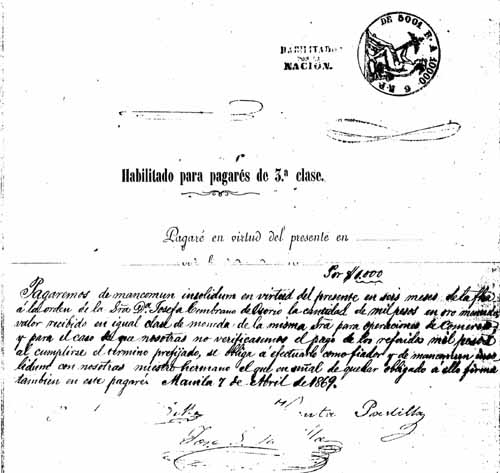Article 7 of the Royal
Decree of May 26, 1835, above quoted, was “clarified” by the Royal Order
of February 22, 1836, which provided that the Second and Third copies of
all Bills of Exchange, “when there Is need of using them,” must also be
written upon the stamped paper for documentos de giro (documents
for. the circulation of money).
| The Royal Order
of July 17, 1836, to which reference has already been made provided; “….
that inasmuch as at present no information is had of the supply necessary
for the consumption of one year, there is committed to the General Administration
of “Rentas Estancada” (Stamp Revenues) the command that the
remittance be accomplished in abundant consignments, which there
will be no necessity of invalidating in case of remainders,
because, since it bears, to indicate the year, the number 183____ with
the object of putting the last figure which corresponds to it on
that which is inscribed, said supply is valid for
a decennial (ten years)”. [48] |
It may
be inferred from this first issue of the special stamped paper for
documentos de giro, which was probably received from Spain during 1836,
was valid until December 31, 1839. Beginning with January 1, 1840, it is
presumed that a new series of stamped paper for documentos de giro was
issued at the beginning of each decennial period.

Figure 27
Figure 27[49]
bears a stamp design, which was current on papel sellado during the period
between 1850 and 1867. It must be noted that on this example only the first
two figures of the date are printed. This example is a 3rd class Documentos
de Giro for amounts ranging from 5,001 to 10,000 reales and surcharged
“HABILITADO POR LA NACION” and “Habilitado para pagares de 3.a clase” and
used in Manila on April 7, 1869. Even in used form, it is not possible
from these figures to determine the decennial period for which it was issued.
It is possible that this paper was issued for each decennial period, beginning
with 1836.
It cannot still be
explained on why the above example, measuring 20.3 cm x 24.75 cm, was surcharged
with “Habilitado para pagares de 3.a clase” (with rubricas that constitute
part of the surcharge) which, as issued, is already a third class paper
with a value of 6 reales and valid for amounts 5,001 to 10,000 reales.
The State also issued
blank sheets on which only the stamp was printed. By Article 4 of the Royal
Decree of May 26, 1835, a person might purchase these blank sheets and
have his own forms for the documents printed thereon, including distinctive
emblems by which he, or his business, was identified.
Figure 28 [49] is
a 4th Class Documentos de Giro valued at 12 reales and for amounts ranging
from 10,001 to 20,000 reales, used in Binondo, Manila, on October
17, 1858. This is an example of the blank form with the emblem of
the Banco Español Filipino is printed on it. |

